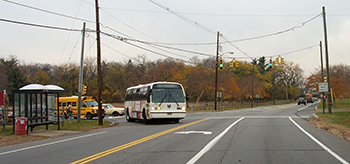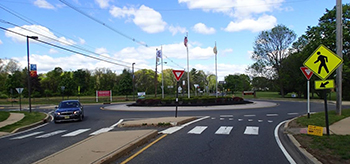A Roundabout Way of Fixing Dangerous Roads
Replacing intersections with modern circles, narrowing lanes among safety initiatives

Courtesy of Monmouth County, NJ
Monmouth County, NJ installed a modern roundabout at the entrance
to Brookdale Community College. The intersection is shown
before (above) and after (below) the improvements were made.
 Across the country engineers and planners are turning to innovative techniques to make roads more “complete.” In North Jersey, modern roundabouts are replacing complex intersections in suburban areas, while downtowns are using a different approach—a narrowing of lanes called “road diets”—to make streets safer for all users.
Across the country engineers and planners are turning to innovative techniques to make roads more “complete.” In North Jersey, modern roundabouts are replacing complex intersections in suburban areas, while downtowns are using a different approach—a narrowing of lanes called “road diets”—to make streets safer for all users.
Roundabouts
In Monmouth County, the intersection of Crine, Dutch Lane and Heulitt roads had become one of the most dangerous in Colts Neck and something needed to be done to change that.
“A traffic signal would have been very difficult to design so that the signal heads were placed in positions where they were visible to the approach road and yet not necessarily visible from the other approaches,” Monmouth County Engineer Joseph Ettore said.
So the county set out to find a solution that would reduce the number of serious crashes. After conducting a study, the county decided a modern roundabout, which forces all oncoming traffic to yield to the vehicles in the circle and reduce speeds when traversing the intersection, was the best solution.
“We find that in some situations, specifically with unconventional [road configurations] they do make the solution much simpler than a traffic signal, which can get very complicated when you have severe skew angles on the approach roads,” Ettore said.
Roundabouts are smaller in size than the old traffic circles that were once commonplace in New Jersey. All traffic entering a roundabout must yield to vehicles already in the intersection and vehicles stay in their lane, unlike older traffic circles, which had multiple lanes that cars had to move between to exit. Roundabouts are one aspect of a broader lane reduction strategy, known as a road diet, which aims to lower speeds, improve traffic flow, reduce serious crashes and increase safety.
The Federal Highway Administration (FHWA) encourages the use of road diets and roundabouts to make roadways safer for all users.
The Colts Neck roundabout opened in mid-2015 and while it’s too early to compare pre- and post-installation data, Ettore said the new configuration has been effective at slowing traffic. And lower speeds mean that even if there is a crash, it’s less likely to result in severe injuries.

Courtesy of Monmouth County, NJ
Colts Neck, New Jersey, showcases the community's farming
roots with a bronze horse statue in the middle of a roundabout.Ettore said, as a policy, Monmouth County considers modern roundabouts as an option any time it is studying an intersection for improvement. Since 2007, Monmouth County has replaced three intersections with roundabouts and two more projects are being designed.
Road Diets
Mark Doctor, a FHWA safety and design engineer, said such studies of local conditions are important for considering roundabouts and complementary road diet approaches such as adding turn lanes, adding corner bump-outs, and other measures along a corridor.
“Road diets are a great strategy for improving safety, but a certain type of safety problem,” he said. Doctor said road diets are particularly effective in reducing rear-end crashes and improving overall safety.
But first, Doctor said a community must understand what the problem is—assuming it is even safety-related. Road diets can be implemented to create bicycle lanes, add on-street parking and even slow traffic to encourage motorists to patronize a business district.
“Sometimes road diets are put in to enhance economic development,” he said.
After goals are identified, Doctor said the next step is to conduct a traffic study, that not only looks at daily volume but also what the peak hour conditions are now and what they would look like following any proposed changes.
Looking at intersections is key. Doctor said it’s important to consider how any changes would affect an intersection, which he described as a road’s “capacity control point.”
“One of the things we look at is possible retiming of signals, also opportunities to reallocate space at the intersection,” he said. “For example, maybe by going to a road diet we have an opportunity to put in a left-turn lane where one doesn’t exist today. In some instances it is possible that we’re improving operations at the intersection.”
FHWA has found that road diets reduce crashes by 19 to 47 percent on average.
Like Monmouth County, Passaic County, New Jersey, has also implemented a policy to take a more holistic approach to road improvement projects. Passaic County Senior Planner Michael Lysicatos said the county was the first in the state to adopt a complete streets implementation plan and framework. This means anytime the county is doing a road project, it considers complete streets elements, like road diets.
FHWA encourages all communities to take a proactive approach, as Passaic County does, and consider road diets as part of the regular resurfacing schedule.
Lysicatos said road diets are relatively low-cost and easy to implement when included as part of a resurfacing project. And the county has seen great success in improving safety through the use of these design changes.
For example, a road diet along Valley Road, from Urban Club Road to Berden Avenue, in Wayne in 2012 resulted in a 52 percent reduction in overall crashes and a 61 percent reduction in dangerous crashes, according to data from New Jersey Department of Transportation.
Lysicatos, Doctor and Ettore all stressed that it’s important to work with the local community ensure the proposed changes are the best solution for the project.
Doctor said communities can implement a trial road diet by using temporary pavement markings to test out the changes for a few months before going ahead with resurfacing or a larger construction project. He said this allows the agency doing the project to get public and stakeholder input on the plans.
Ettore said public education can make a big difference. When Monmouth County completed its first roundabout project at the entrance of Brookdale Community College in Middletown, it distributed brochures to the public and around campus to explain how the new intersection worked.
The county also holds public information sessions on all of its projects before work begins.
Melissa Hayes is the managing editor of InTransition.